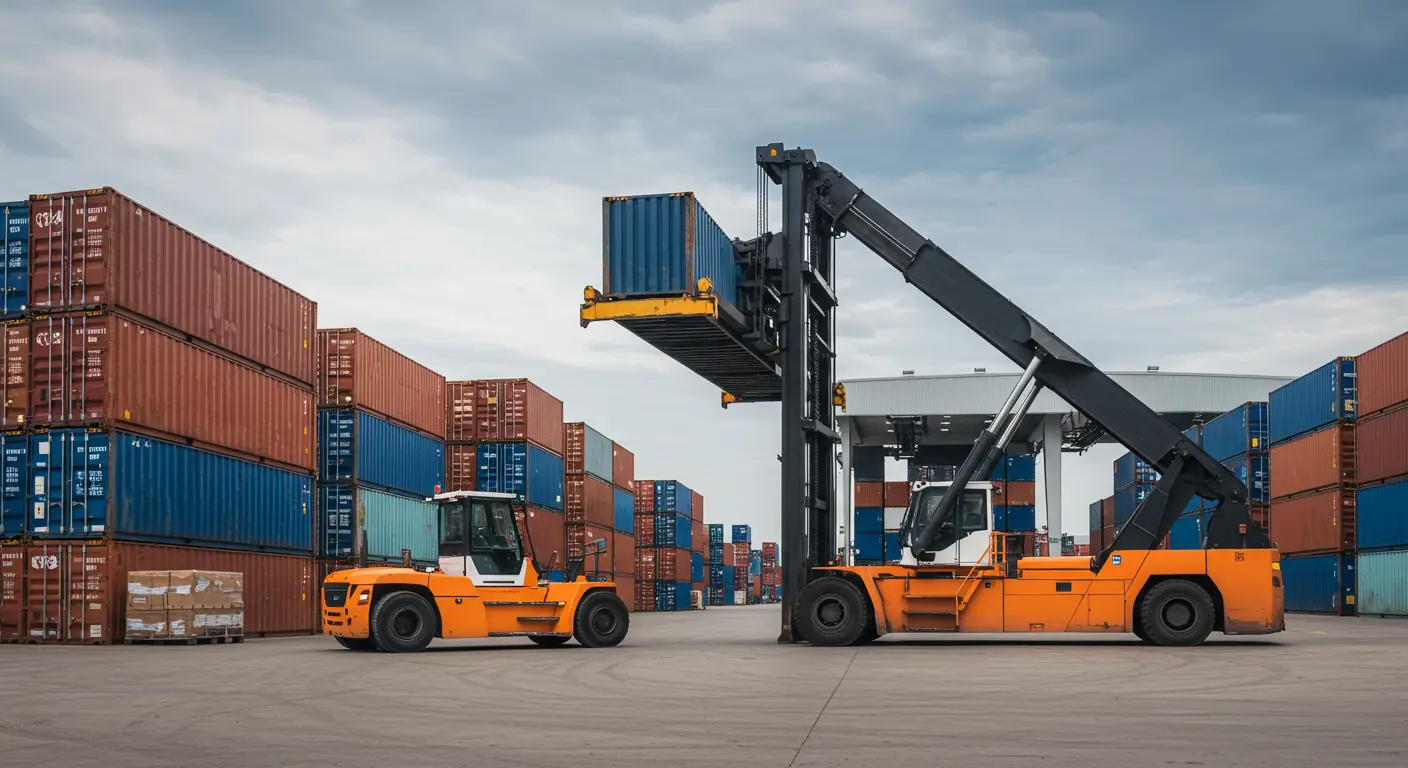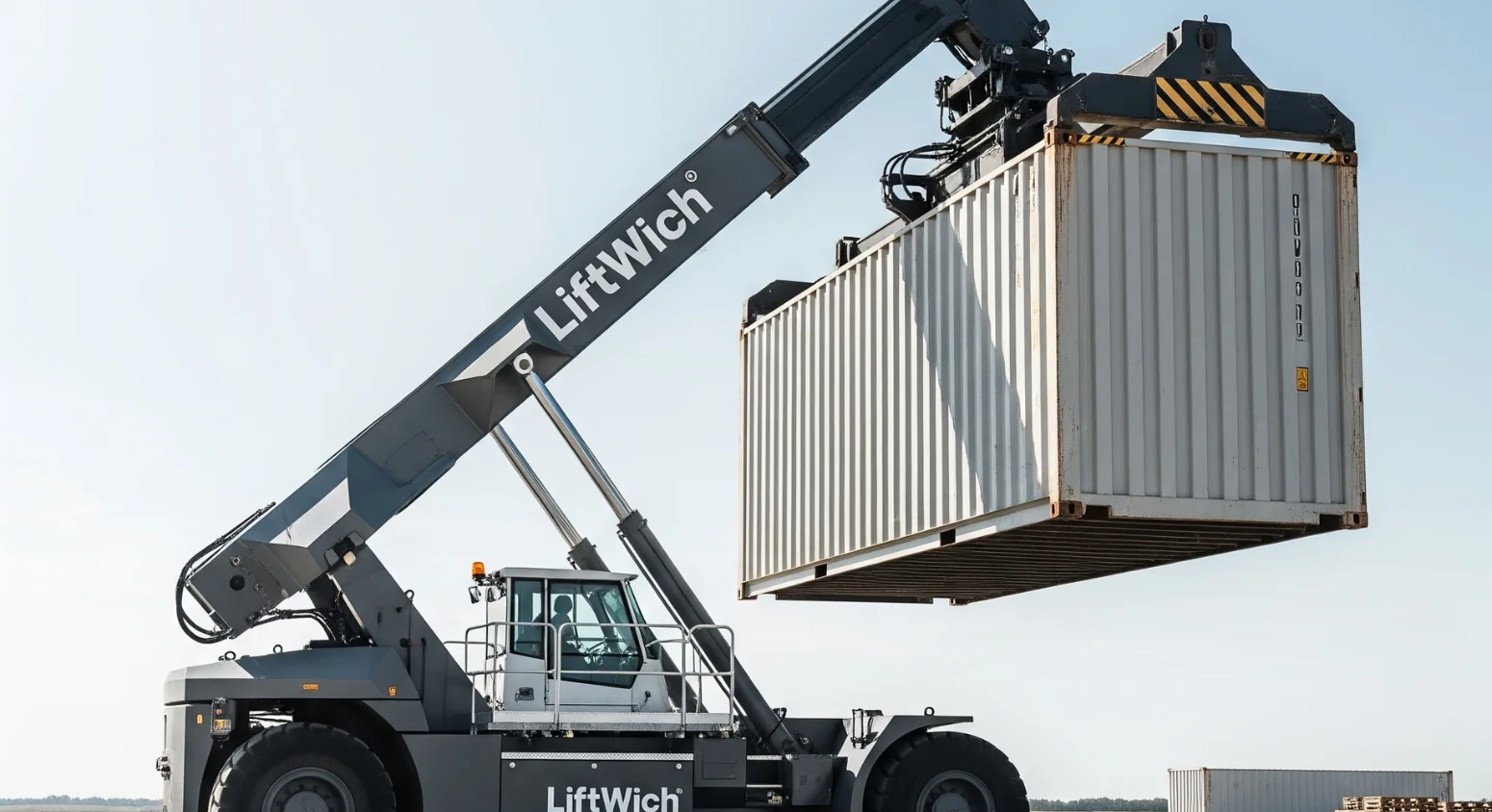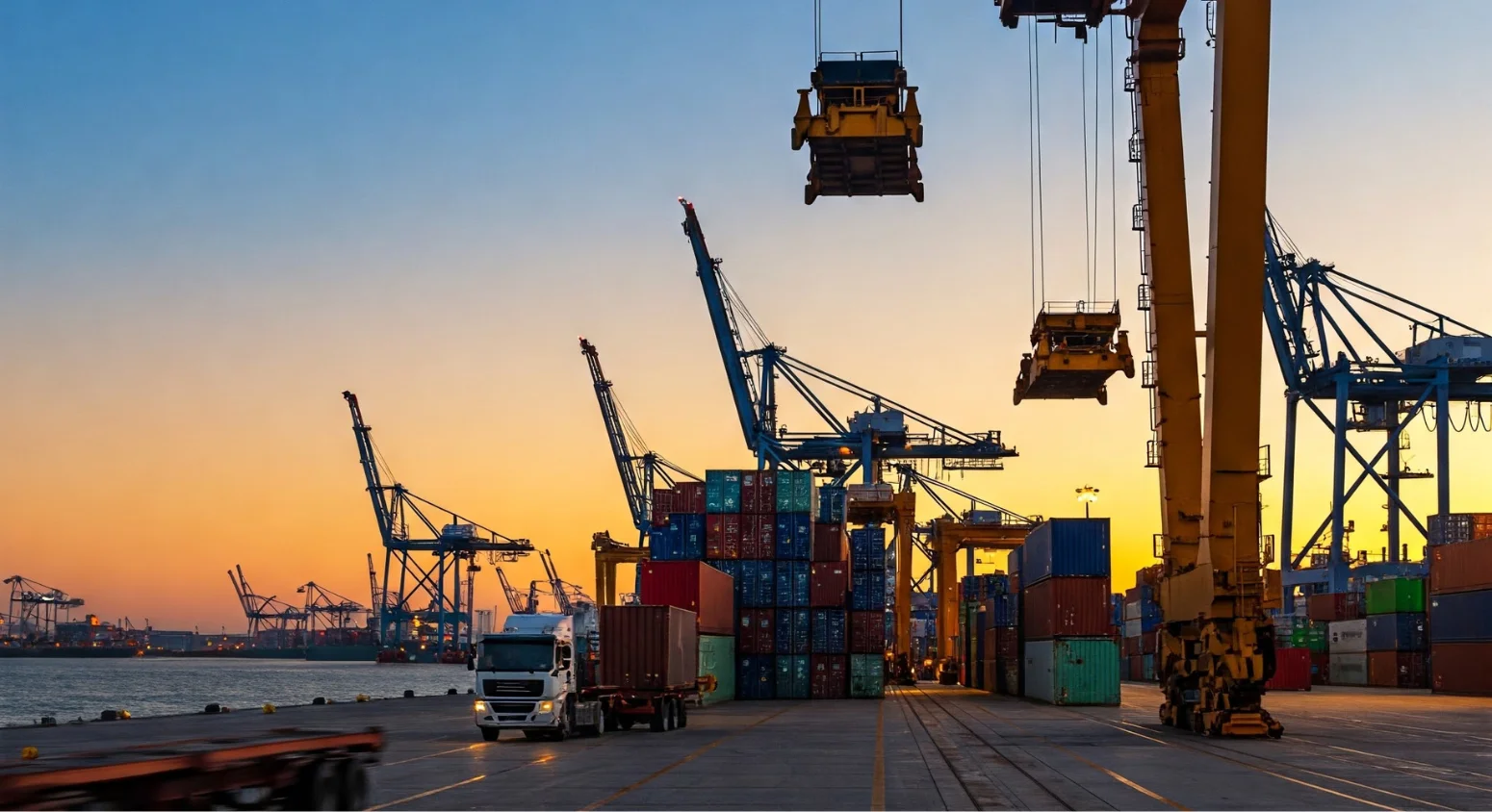When it comes to shipping containers, efficiency is everything. Whether you’re handling a few containers for a small operation or a whole port or warehouse, the right gear makes all the difference. Have you ever struggled to move a container across the rough ground or lift one onto a vehicle? It can seem like a nightmare, but the right tools like shipping container wheels or container jacks can turn these tasks into a breeze.
In this guide we’ll look at the top container handling equipment for every operation. From small solutions like a shipping container dolly for tight spaces to big tools like a shipping container tow bar for long hauls, there’s a world of options to increase efficiency and reduce labor. Let’s get started and find the essential tools to take your container management to the next level!
Container Handling Equipment
If you’ve worked in logistics, warehousing, or shipping you know container handling is no joke. Moving heavy containers requires precision, planning, and most importantly the right equipment. But how do you decide what’s right for you?
Container handling equipment is designed to make transporting, lifting, and placing shipping containers easier whether you’re dealing with small loads or high-volume operations. Here’s why it matters:
- Efficiency: The right equipment saves time and labor so you can focus on other priorities.
- Safety: Using purpose-built equipment like container lifting jacks reduces the risk of accidents and damage to personnel and goods.
- Cost Savings: By investing in reliable equipment you can avoid frequent repairs and replacements and save money.
Key Points to Consider
When choosing container handling equipment you need to consider your specific operation. Ask yourself:
What’s the size of my operation?
For smaller operations, a shipping container dolly might be enough, great for maneuverability. For larger-scale operations cranes or container lifting systems might be required.
What kind of terrain will the equipment handle?
Uneven or rough surfaces might require special shipping container wheels to move smoothly without damaging your equipment or cargo.
How often will the equipment be used?
If you’re handling containers frequently, investing in heavy-duty, high-capacity equipment will pay off in the long run.
By understanding what each piece of equipment can do you can make better decisions and get more out of your workflow. The result? A smoother, safer, and more cost-effective container management process for you.
Stay tuned as we delve into the best equipment for small, medium, and large-scale operations in the sections ahead!
Small Scale Operations
Running a small-scale operation doesn’t mean you have to compromise on efficiency or safety. In fact having the right tools is even more important when you have limited resources or space. So how can you make container handling easier without breaking the bank? Let’s look at some practical solutions for smaller setups.
Compact and Budget Friendly Solutions
- Shipping Container Dolly: A shipping container dolly is a game changer for small-scale operations. Designed for maneuverability it allows you to move containers easily even in tight spaces like warehouses or storage yards. These dollies are lightweight yet strong so they are a budget-friendly option for businesses that handle limited container loads.
- Container Lifting Jacks: When it comes to lifting containers safely container lifting jacks are a must-have. They’re perfect for smaller operations that don’t have access to large cranes. With these jacks, you can lift containers for maintenance, placement, or loading onto a vehicle with minimal effort.
- TriWich Solution: The TriWich LiftWich System provides a compact, portable lifting solution ideal for smaller setups. It delivers exceptional stability and precision for safe container elevation.
3. Shipping Container Wheels: If you need to move containers over short distances shipping container wheels are a solution. These wheels can be attached and turn heavy containers into mobile units that glide across flat surfaces.
Why These Work for Small-Scale
- Space Efficiency: Dollies and wheels take up minimal space when not in use.
- Budget Friendly: These options are great value for money especially for businesses that don’t need heavy-duty machinery.
- Ease of Use: Compact tools are easy to use, and no special training is required for your team.
Tips to Get the Most Out of It
To get the most out of these:
- Do regular maintenance to prolong life and performance.
- Train your team on safe handling especially when using lifting jacks.
- Assess your space to make sure you can move around easily and minimize obstacles.
Small-scale operations can benefit from the right container-handling equipment. Choose multi-purpose tools like a shipping container dolly or container lifting jacks and you’ll be more efficient and productive without breaking the bank. Ready to go bigger? Let’s look at the medium scale in the next section!
Equipment for Medium-Scale Operations
When your operation grows, so do the demands on your equipment. Medium-scale container handling requires tools that balance power, efficiency, and versatility. You’re no longer dealing with just a few containers—you’re managing more significant loads, tighter schedules, and diverse terrains. So, what’s the best way to stay ahead without overcomplicating your processes?
Versatile Tools for Growing Operations
Forklifts with Container Attachments
The forklifts are the medium-scale backbone operations. With appropriate attachments, they can handle shipping containers of all sizes efficiently. Such tools are perfect for moving containers around warehouses or even short distances in outdoor areas, both strong and agile.
Towable Solutions: Shipping Container Tow Bar
A shipping container tow bar is an excellent addition for medium-scale businesses. It enables you to attach containers securely to vehicles, making it easier to transport them across longer distances. This is particularly useful for businesses needing flexibility in container movement.
TriWich Modular Systems
The TriWich HitchWich System is a kind of modular medium-sized operation solution. This system enables you to tow containers using any vehicle, giving you flexibility and efficiency. This is a solid option for operations where containers need to be moved constantly without the requirement of heavy-duty machinery.
Portable Container Lifting Jacks
When precision counts, go for container lifting jacks. They find perfect application in raising containers for placement on trailers or other purposes. Their portability makes them particularly suitable for medium-scale operations with diverse needs.
Why These Solutions Perfectly Suit
Scalability: Tools like the HitchWich System evolve with you, meaning you’re allowed to work with increasing loads without a complete overhaul.
Flexibility: Whether it is moving containers onsite or moving them between locations, these tools offer versatility for different tasks.
Cost-Effectiveness: Medium-scale solutions, such as a shipping container tow bar, are designed to deliver maximum efficiency without requiring a significant financial investment.
Pro Tips for Medium-Scale Efficiency
- Opt for multi-functional equipment to handle a variety of tasks with a single investment.
- Regularly inspect your tow bars, jacks, and modular systems to ensure they’re in top condition.
- Train your team on safe handling procedures, especially when using portable lifting systems.
Large-Scale Machines
With a large-scale comes the challenges. High-volume containers, short schedules, and efficient workflow necessitate the right equipment. But how to ensure that tools can handle the heavy load without compromising on safety and productivity? Here’s a dive into the core machinery engineered for large-scale container handling.
High-Capacity Solutions for Peak Efficiency
1. Crane Systems- That Executed Lifting with Precision
Crane systems are the heart of any heavy-duty operation. They provide unmatched strength and precision. Whether lifting and moving heavy containers in a busy port or industrial site, these systems do it with ease. Their versatility makes them the heart of high-capacity workflows.
2. Reach Stackers for High-Capacity Storage
The reach stackers are used exceptionally for moving containers in compact spaces and even stacking inside tall storage warehouses. They overstretch into multiple levels for full use of space in large warehouse spaces and ports. They utilize every inch in an expansive room.
3. Automated Guided Vehicles
AGVs are one of the recent innovations for processes that require fast and consistent output. It drives on pre-charted routes, and it is designed to automatically accept containers, thus minimizing errors by humans, and creating process flow in systematically efficient places especially.
4. TriWich Heavy-Duty Container Solutions
Tri-Up System: The TriWich Tri-Up System provides a new solution for loading and unloading containers from flatbeds without the use of stacker handlers. This is a very practical approach that simplifies workflows while reducing dependence on heavy machinery.
Why These Tools Are Ideal for Large-Scale Operations
Productivity: AGVs automate cyclic and repetitive tasks, thus ensuring productivity and avoiding machine idle time.
Reliability: These tools are designed for harsh environments and, therefore, have durability with low maintenance and replacement costs.
Best Practices for Optimizing Large-Scale Operations
- Invest in Automation: Invest in the use of tools such as AGVs or automated crane systems, which reduce labor and increase speed.
- Safety First: Train your people properly and invest in tools, ensuring safety in each and every operation.
Selecting the Right Container Handling Equipment for Your Operation
In container handling, one size does not fit all. Your operation’s success depends on the right selection of equipment that will match your needs. So, how do you make the right choice? Let’s explore the factors to consider and how to match them with the perfect tools for your operation.
Key Considerations When Selecting Equipment
Scale of Operations
Are you managing a small storage yard, a mid-sized warehouse, or a sprawling port? The size of your operation determines the scope of equipment capacity required.
- Small operations would be well served with compact solutions, such as shipping container dollies or container lifting jacks, to ensure an easy and affordable handling process.
- Large operations require heavy-duty solutions, including crane systems or the versatile HitchWich System for seamless container movement.
Types of Containers
The size, weight, and purpose of your containers matter.
- For general ISO containers, easy-access solutions like the Tri-Up System will be very helpful for flatbed loading and unloading.
- Specialized loads such as machinery, generators, and heavy materials may be suited to be transported with systems similar to the AnyWich.
Transportation Requirements
How often and how far are you transporting your containers?
- The use of shipping container wheels or a wheel dolly might be handy for short-distance transports.
- For longer distances, there is the LiftWich System that efficiently and eco-friendly transport your containers.
Budget and Space Requirements
The general principle to balance functionality and cost-effectiveness, especially for a small business. Choose multiple tools that can be stored easily, such as HitchWich for towing, or AnyWich to manage multiple scenarios.
Why the Right Container Handling Equipment Matters
Using the right container handling equipment will result in:
- Efficiency – less downtime, processes get optimized.
- Safety is safer for your workers and equipment.
- Cost-Effectiveness: Invest in tools that offer long-term value.
Pro Tips for Making an Informed Decision
Evaluate Your Workflow
Map out your handling process to identify bottlenecks. For instance, if loading containers onto trucks is time-consuming, consider solutions like the Tri-Up System to speed things up.
Test Before You Invest
Whenever possible, demo equipment to ensure it meets your requirements. Many providers, including TriWich, offer product demonstrations to help you make confident choices.
Plan for Scalability
Choose equipment that can adapt as your operation grows. Systems like HitchWich and LiftWich are designed with scalability in mind, making them ideal for both smaller and larger-scale operations. Investing in scalable solutions ensures that your equipment remains useful and efficient as your needs evolve.
Effective Use and Servicing for Best Outcome
In itself, container handling equipment doesn’t make a difference in the world. You’re only halfway to where you want to go. Instead, it is really about how efficiently you maintain and use your equipment. Unless you use or service it, you can lose valuable operating time, increase costs, or even compromise safety. How do you maximize your equipment? Let’s break it down.
Best Practices: Proper Usage
Train Your Team
A well-trained team is the first line of defense against inefficiency and accidents.
- Provide the team with hands-on training on the proper use of equipment.
- Keep updating the training in the wake of new tools or processes.
Obey the manufacturer’s guidelines
- Each equipment has guidelines from the manufacturer in relation to their safe and efficient use. For example, never fail to place the container in the proper position during loading or unloading while using the Tri-Up System.
- Do not overload beyond weight limits and do not use equipment over unsuitable ground.
Use the Right Tool for the Job
Do not use makeshift arrangements that may mar your equipment and also jeopardize safety as well.
- You use AnyWich systems for heavy trucks or generator and wheel dollies for shorter moves of car moving.
- Equipment is to be geared to the intended job.
How Regular Maintenance Affects Your Operation
Good, well-maintained equipment lasts longer, works better and keeps your operation running better. Here’s how to maintain them:
- Pre-Servicing And Post-Servicing Inspection
- Look for obviously visible signs like fraying of cables, rust, or looseness of parts.
- For equipment such as HitchWich System, inspect all attachment points for safe towing
Maintenance Schedule
Minor problems do not become costly repairs if maintained regularly.
- Lubricate and clean moving parts to prevent rust and ensure smooth movement.
- Schedule regular professional inspections for equipment such as the LiftWich System if it is frequently used.
- Replace Worn Parts As Soon As Possible
- Do not wait to replace damaged or worn parts.
For example, replace the dollies’ wheels when they are very worn out so that the operations will not be down-timed.
Benefits of Right Use and Maintenance
- Productivity: Good tools are put in order so that the workflows are hastened at maximum performance.
- Cost Saving: It may avoid costly repair and replacement through preventive care.
- Safe Operations: Proper use and maintenance of tools prevent accidents or breakdown of equipment.
Pro Tips for Long-term Efficiency Maintenance
- Prepare checklists: A checklist list should be maintained to be followed by the employees in a continuing manner for pre-use and post-use purposes.
- Record of the maintenance: Maintenance records should be made through which all repairs and replacements can be identified for finding repetition and optimization of procurements henceforth.
- Leverage Expert Support: With TriWich and many other companies comes the ability to use the services of supporting and maintaining products. Use it and keep your tools in a good condition.
Conclusion
Container handling, whether for small projects or large operations, requires efficiency, safety, and the right equipment. The right tools not only streamline workflows but also reduce costs and improve productivity.
With the right equipment, appropriate maintenance, and the right staff training, performance and longevity will be maximized. Take some time to assess your current set-up—are inefficiencies holding you back?
With the right strategy and the right tools, you can conquer any challenge, optimize your operations, and achieve long-term success.
Frequently Asked Questions
Why should the right container handling equipment be chosen?
It ensures that you work efficiently and safely and also at a minimal cost. With the right equipment, the processes will run efficiently with reduced labor hours, with little or no accidents or breakage of the products.
Which are the tools that are necessary for small-scale container handling?
For smaller operations, compact tools like shipping container dollies, container lifting jacks, and shipping container wheels are best suited. They provide maneuverability, affordability, and ease of use in limited spaces.
How do I take care of my equipment to handle my containers?
Check for wear before and after you use it and perform scheduled maintenance activities such as lubricating your parts, cleaning your equipment, and replacing worn-out components.
Correct Usage: Use the equipment as recommended by the manufacturers. Avoid overloading of any equipment.
Training: Your employees should know how to correctly and safely utilize the tools.
Can all container handling work be done with one type of equipment?
No. Each tool is made for a particular job, like towing, lifting, or short-distance movement. For instance, the HitchWich System is good for towing containers with trucks or tractors. The Tri-Up System is good for flatbed loading and unloading.



